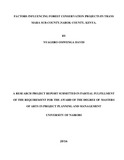| dc.description.abstract | The study was to investigate factors influencing forest conservation on improving environment in Trans Mara sub-county, Narok County, Kenya. Residents of Trans Mara sub-county are concerned with climate change, prolonged draught and changing rain patterns due to forest destruction which has manifested itself in the form of deforestation, the shamba system, human settlements, cultivation, charcoal production and grazing. The purpose of the study was to investigate factors influencing forest conservation on improving environment in Trans Mara Sub-county, Narok County. This study was out to achieve the following specific objectives; the effect of the sources of income among the rural population living next to forests, level of awareness of these population on the importance of forest as well as level of education, social cultural factors and government policies on forest conservation in Trans Mara sub-county. The study’s findings are expected to be beneficial to the people of Trans Mara sub-county and the general public on understanding the importance of conserving forest resources. On literature review, Forest and woodlands are declining primarily as result of increase in wood fuel collection, conflicts, increasing urbanization and industrialization, FAO, (2000). These opportunities are diminishing. Between 1990 and 2000, Africa’s forest and woodlands receded faster than the global average; deforestation in Africa to place at an average of 0.8 percent, as compared to the world average of 0.2 percent, FAO,(2005). Relative participation of men and women in various capacities of decision making has been the key items in forest conservation. Despite the above scholars’ contributions in forest conservation, there is more to be studied. Influence of high school students in forest conservation and community around the forest to get 30% of the revenue to be fully involved in forest conservation. The study was based on the tragedy of commons theory. Conceptual framework was used to show the relationship between dependent and independent variables. The study adopted a descriptive survey design. The targeted population was all the adult people in Trans Mara sub-county. The sample consisted of 400 adults around Nyakweri forest and Masaai Mara game reserve. Structured questionnaire, interview schedules, documentaries, photography and observation were used to collect information from respondents. Content validity was ascertained through expert judgment while reliability was established through test retest. Questionnaires were hand delivery and picked by the researcher who also conduct interviews to forest officers. Data analysis was done by both qualitative and quantitative techniques. Quantitative data was analyzed by use of simple descriptive statistics that is, frequencies, percentages and averages. The qualitative data was analyzed and reported in narrative form. Data was analyzed, presented and interpreted by use of tables and a summary. Conclusion and recommendation of the study done. The findings showed that poverty and level of education were the major cause of poor implementation of forest conservation measures. Others were inadequate financing, policies as well as social-cultural factors. In conclusion, it was found that source of income and education remains the major challenges to implementation of forest conservation measures. The study recommended that poverty eradication strategies and youth empowerment programs should be enhanced. | en_US |

